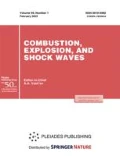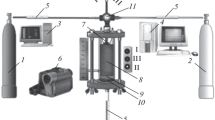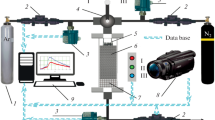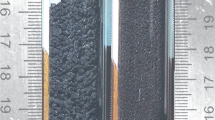Abstract
This paper touches upon the effect of a polyvinyl butyral content (0–2.3%) on the combustion of a Ti + C granular mixture with different types of titanium. Experiments are carried out with no external gas flow, so conductive combustion is expected to be observed due to a low decomposition temperature and a small amount of polyvinyl butyral. However, convective combustion is manifested in rapidly burning mixtures because the granule surface is ignited with hot gaseous decomposition products of polyvinyl butyral. It is explained how undecomposed polyvinyl butyral falls behind the ignition front, and it is revealed that the type of combustion of the Ti + C granular mixture depends on its burning rate in the case where no gas flows through the sample. Based on the experimental and theoretical analysis of the combustion process, it is established that granules are ignited during convective combustion at a temperature of the \(\alpha \to \beta\) transition in titanium. The different effect of a polyvinyl butyral content on slowly and rapidly burning Ti + C mixtures is qualitatively explained.






Similar content being viewed by others
REFERENCES
A. Varma and A. S. Mukasyan, “Combustion Synthesis of Advanced Materials: Fundamentals and Applications," Korean J. Chem. Eng.21 (2), 527–536 (2004).
K. V. Manukyan, Y.-C. Lin, S. Rouvimov, et al., “Microstructure–Reactivity Relationship of Ti + C Reactive Nanomaterials," J. Appl. Phys. 113, 024302 (2013); doi.org/10.1063/1.4773475.
H. H. Nersisyan, J. H. Lee, J.-R. Ding, et al., “Combustion Synthesis of Zero-, One-, Two- and Three-Dimensional Nanostructures: Current Trends and Future Perspectives," Prog. Energy Combust. Sci. 63, 79–118 (2017); dx.doi.org/10.1016/j.pecs.2017.07.002.
B. S. Seplyarskii, “The Nature of the Anomalous Dependence of the Velocity of Combustion of ‘Gasless’ Systems on the Sample Diameter," Dokl. Akad. Nauk 396 (5), 640–643 (2004) [Dokl. Phys. Chem. 396 (5), 130–133 (2004)].
B. S. Seplyarskii and S. G. Vadchenko, “Role of Convective Heat Transfer in Gasless Combustion by the Example of Combustion of the Ti–C System," Dokl. Akad. Nauk 398 (1), 72–76 (2004) [Dokl. Phys. Chem. 398 (1), 203–207 (2004)].
B. S. Seplyarskii, S. G. Vadchenko, S. V. Kostin, and G. B. Brauer, “Combustion of Ti+0.5C and Ti+C Mixtures of Bulk Density in Inert Gas Coflow," Fiz. Goreniya Vzryva 45 (1), 30–37 (2009) [Combust., Expl., Shock Waves 45 (1), 25–31 (2009)].
A. Varma and J.-P. Lebrat, “Combustion Synthesis of Advanced Materials," Chem. Eng. Sci. 47 (9-11), 2179–2194 (1992).
A. I. Kirdyashkin, Yu. M. Maksimov, and E. A. Nekrasov, “Titanium–Carbon Interaction Mechanism in a Combustion Wave," Fiz. Goreniya Vzryva 17 (4), 33–36 (1981) [Combust., Expl., Shock Waves 17 (4), 25–31 (1981)].
M. A. Ponomarev, V. A. Shcherbakov, and A. S. Shteinberg, “Combustion of Thin Layers of a Titanium–Boron Powder Mixture," Dokl. Akad. Nauk 340 (5), 642–645 (1995).
A. K. Filonenko, V. A. Bunin, and V. I. Vershinnikov, “Burning Rate versus Diameter for Some Gasless Compositions," Khim. Fiz.1 (2), 260–264 (1982).
B. S. Seplyarskii and R. A. Kochetkov, “Combustion of Powder and Ti + xC (\(x>0.5\)) Granular Compositions in a Cocurrent Gas Flow," Khim. Fiz.36 (9), 23–31 (2017); DOI: 10.7868/S0207401X17090126.
B. S. Seplyarskii and R. A. Kochetkov, “Granulation as a Tool for Stabilization of SHS Reactions," Int. J. Self-Propag. High-Temp. Synth. 26 (2), 134–136 (2017); DOI: 10.3103/S106138621702011X.
N. A. Kochetov and S. G. Vadchenko, “Effect of the Time of Mechanical Activation of a Ti + 2B Mixture on Combustion of Cylindrical Samples and Thin Foils," Fiz. Goreniya Vzryva51 (4), 77–81 (2015) [Combust., Expl., Shock Waves51 (4), 467–471 (2015)]; DOI: 10.1134/S0010508215040103.
A. G. Merzhanov and A. S. Mukas’yan, Solid-Flame Combustion (Torus Press, Moscow, 2007) [in Russian].
B. S. Seplyarskii, R. A. Kochetkov, T. G. Lisina, et al., “Phase Composition and Structure of Titanium Carbide/Nickel Binder Synthesis Products," Neorg. Mater. 5 (11), 1169–1175 (2019) [Inorg. Mater. 55 (11), 1104–1110 (2019)]; DOI: 10.1134/S0002337X19110113.
A. A. Zenin, A. G. Merzhanov, and G. A. Nersisyan, “Thermal Wave Structure in SHS Processes (by the Example of Boride Synthesis)," Fiz. Goreniya Vzryva 17 (1), 79–90 (1981) [Combust., Expl., Shock Waves 17 (1), 63–71 (1981)].
B. S. Seplyarskii, R. A. Kochetkov, and T. G. Lisina, “Convective Combustion of a Ti + 0.5C Granulated Mixture. Domain of Existence and Fundamental Phenomena," Fiz. Goreniya Vzryva 55 (3), 57–62 (2019) [Combust., Expl., Shock Waves 55 (3), 295–299 (2019)]; 10.1134/S0010508219030079.
A. V. Lykov, Theory of Thermal Conductivity(Vysshaya Shkova, Moscow, 1967) [in Russian].
N. G. Kasatskii, V. M. Filatov, and Yu. S. Naiborodenko,Self-Propagating High-Temperature Synthesis (Izd. Tomsk. Univ., Tomsk, 1991) [in Russian].
M. A. Gol’dshtik, Transfer Processes in a Grain Layer (Kutateladze Institute of Thermophysics of the Siberian Branch of the Academy of Sciences of the USSR, Novosibirsk, 1984) [in Russian].
L. K. Gusachenko, V. E. Zarko, A. D. Rychkov, and N. Yu. Shokina, “Filtration Combustion of an Energetic Material in a Cocurrent Flow of Its Combustion Products. Critical Combustion Conditions," Fiz. Goreniya Vzryva 39 (6), 97–103 (2003) [Combust., Expl., Shock Waves 39 (6), 694–700 (2003)].
B. S. Seplyarskii, R. A. Kochetkov, and T. G. Lisina, “Theoretical and Experimental Method for Calculating the Conditions of the Convective Mode of Combustion," Khim. Fiz. 38 (3), 24–29 (2019) [Russian Journal of Phys. Chem. B. 13 (2), 267–272 (2019)]; DOI: 10.1134/S0207401X19030063.
B. S. Seplyarskii, R. A. Kochetkov, and T. G. Lisina, “Coflow Combustion in Granulated Ti + xC Mixtures: Boundary Conditions for Convection-Driven Wave Propagation," Int. J. Self-Propag. High-Temp. Synth. 28 (3), 183–186 (2019); DOI: 10.3103/s1061386219030129.
B. S. Seplyarskii et al., “Combustion of Granulated Ti—C Blends: Influence of Granule Size," Int. J. Self-Propag. High-Temp. Synth. 29 (2), 126–127 (2020); DOI: 10.3103/s1061386220020090.
Author information
Authors and Affiliations
Corresponding author
Additional information
Translated from Fizika Goreniya i Vzryva, 2021, Vol. 57, No. 3, pp. 88–96.https://doi.org/10.15372/FGV20210308.
Rights and permissions
About this article
Cite this article
Seplyarskii, B.S., Kochetkov, R.A., Lisina, T.G. et al. Various Types of Combustion of a Ti + C Granular Mixture with a Different Content of the Gasifying Additive. Combust Explos Shock Waves 57, 334–342 (2021). https://doi.org/10.1134/S0010508221030084
Received:
Published:
Issue Date:
DOI: https://doi.org/10.1134/S0010508221030084




